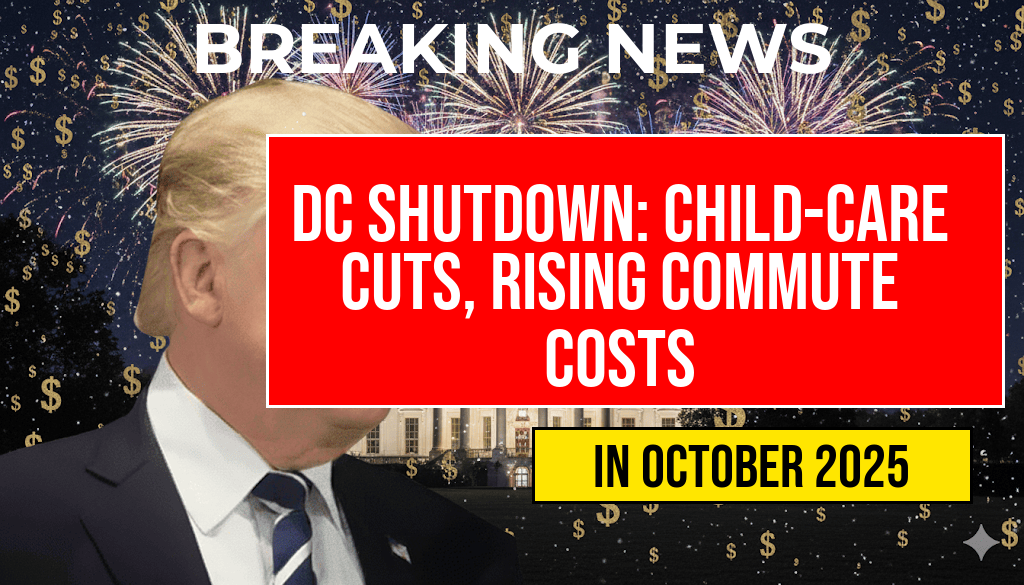The Washington, D.C. metropolitan area is grappling with the consequences of a government shutdown, which has led to significant disruptions in child-care services and increased commuting costs for thousands of residents. As federal employees face furloughs and budgetary constraints ripple through the economy, families are struggling to secure affordable child-care slots, and commuters are experiencing hikes in transportation expenses. With the shutdown extending into its second week, local businesses and service providers are feeling the strain, raising concerns about long-term impacts on the region’s economy and the livelihoods of its residents.
The Impact on Child-Care Services
One of the most immediate effects of the government shutdown has been the loss of child-care slots in the D.C. region. Many local daycares and early childhood education centers rely on federal funding and grants, which have been suspended during the shutdown. As a result, parents are finding it increasingly difficult to find available child-care options.
Statistics on Child-Care Availability
According to a recent survey conducted by the Child Care Aware of America, nearly 30% of child-care providers in the D.C. area have reduced their available spots due to funding issues. The survey also revealed that:
- 40% of parents reported increased difficulty in securing reliable child care.
- 50% of child-care centers have raised their fees in response to financial uncertainty.
- Many providers are limiting hours, further complicating parents’ schedules.
These changes have forced many parents to make difficult decisions, including choosing between work and family obligations. Some families are turning to informal arrangements with neighbors or family members, but these solutions are not sustainable for all.
Rising Commute Costs
In addition to child-care challenges, the shutdown has also led to a surge in commute costs for many residents. With federal employees furloughed or working reduced hours, public transportation systems like Metro have seen decreased ridership, leading to adjustments in service and increasing fare prices. Commuters are now facing higher expenses as they navigate their daily travels.
Transportation Fare Increases
Local transportation authorities have announced fare hikes to offset losses incurred during the shutdown. An analysis from the Washington Metropolitan Area Transit Authority (WMATA) indicates that:
- Metro fares have increased by an average of 10% for peak hours.
- Bus fares have also risen, impacting low-income commuters the hardest.
- Parking costs at Metro stations have doubled in some areas, adding to the financial burden.
These increases are particularly concerning for the many federal employees who rely on public transport to commute to work. With salaries frozen during the shutdown, many are questioning how they will manage their day-to-day expenses.
Local Businesses Feeling the Strain
With both child-care services declining and transportation costs rising, local businesses are also feeling the impact of the government shutdown. As families tighten their budgets, spending on non-essential goods and services has decreased.
Business Responses
Many small businesses, particularly those in the service sector, are reporting a drop in sales. For instance:
- Restaurants in the D.C. area have noted a 20% decrease in customer traffic.
- Child-care providers are struggling to maintain enrollment numbers, forcing some to close temporarily.
- Retail stores are experiencing lower foot traffic as residents prioritize essential purchases.
Local business owners are advocating for swift resolutions to the shutdown, fearing that prolonged financial hardship could lead to permanent closures and job losses.
Looking Ahead
The ongoing government shutdown poses significant challenges for the D.C. region, affecting families, commuters, and local businesses alike. As pressure mounts on lawmakers to reach a resolution, the fallout from the shutdown will likely linger in the coming weeks and months. Community leaders are urging residents to stay informed and engaged, as the repercussions of this situation can have lasting effects on the region’s economy and quality of life.
For more information on the government shutdown and its effects, visit Congress.gov for updates and legislative developments.
Frequently Asked Questions
What impact does the government shutdown have on child-care availability in the DC region?
The government shutdown has led to a significant reduction in child-care slots, as many facilities rely on federal funding and resources. Parents may find it increasingly difficult to secure affordable and accessible child-care options during this period.
How are commute costs affected by the government shutdown?
With the shutdown, many public transportation services may face budget cuts, leading to increased commute costs for residents. Additionally, reduced services can result in longer travel times, further straining commuters financially.
Are there any support programs available for families affected by the shutdown?
Yes, various local organizations and non-profits are mobilizing to provide assistance to families struggling with child-care and commute costs during the government shutdown. Families are encouraged to reach out to these resources for help.
What long-term effects might the government shutdown have on the local economy?
The shutdown could have lasting impacts on the local economy, including a potential decline in consumer spending due to increased commute costs and the unavailability of child-care services, which may force parents to stay home from work.
How can residents stay informed about changes in child-care and transportation services during the shutdown?
Residents are advised to follow local news outlets, government websites, and social media channels for real-time updates on child-care availability and commute costs. Community boards and local organizations may also provide important information.













